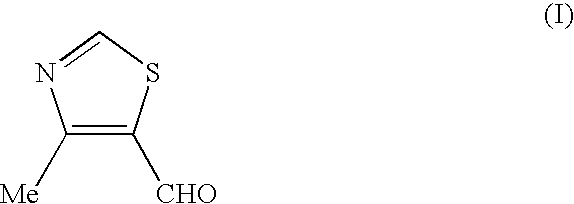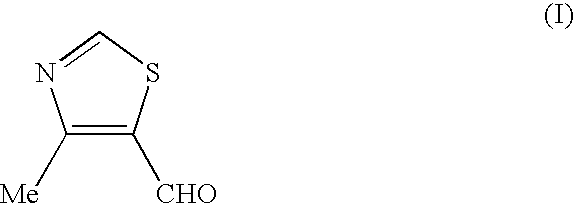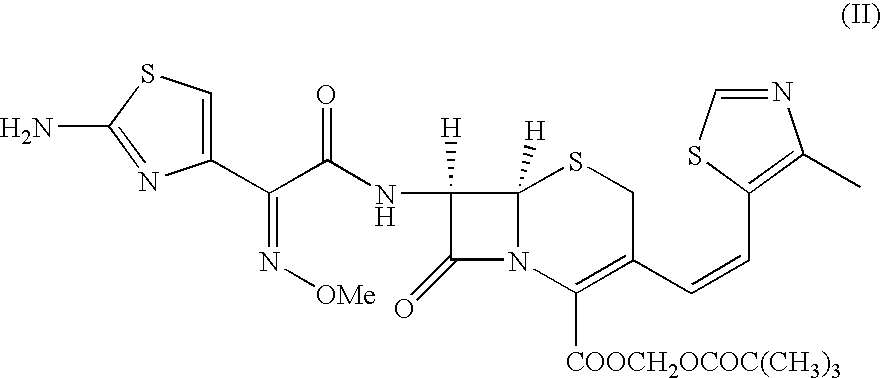Process for the preparation of thiazole intermediate
a technology of thiazole and intermediate, which is applied in the field of preparation of 4methyl5formylthiazole, can solve the problems of reducing agent, high corrosion, hazardous and difficult to handle in large scale, and achieve high yield and high purity of produ
- Summary
- Abstract
- Description
- Claims
- Application Information
AI Technical Summary
Benefits of technology
Problems solved by technology
Method used
Image
Examples
example 2
Preparation of 4-methyl-5hydroxymethyl-thiazole (IV)
[0019] Monoglyme (200 ml) was charged and cooled to -10.degree. C. To this NaBH.sub.4 (40.0 g) was charged in one lot at -10.degree. C. and stirred for 15 minutes. AlCl.sub.3 (47.0 g) was slowly added for 1 hour at -10 to +5.degree. C., stirred for 30 min at 0.degree. C. Then 4-methyl-thiazole-5-carboxylic acid methyl ester (III) (100.0 g) was added for 1 hour at 0-15.degree. C. The reaction mixture was stirred at 15-25.degree. C. for 4 hours and the progress of reaction was monitored by HPLC. The reaction mixture was poured into mixture of ice (500 g) and conc. HCl (200 ml) and stirred for 30 minutes. The reaction mixture was concentrated at 50-60.degree. C. to remove organic solvents from it and cooled the reaction mixture to 5.degree. C. The pH of the reaction mixture was adjusted with sodium hydroxide solution at 5-15.degree. C. up to 12.5 and heated to 45.degree. C. The reaction mixture was extracted with THF (4.times.250 ml)....
example 3
Preparation of 4-methyl-5-formyl-thiazole (I)
[0020] 4-Methyl-5-hydroxymethyl-thiazole (50 gm (0.38 mole)) was added to dichloromethane (300 ml) and stirred for 5 minutes. To this solution, sodium bicarbonate solution (17 g in 250 ml of water) was added at 30-32.degree. C. and stirred the solution for 5-10 minutes at 30-32.degree. C. The reaction mass was cooled to 0.degree. C. and KBr solution (6 g in 10 ml of water) and TEMPO (0.285 g, 0.0018 mole) was added in single lot. To this sodium hypochlorite solution (450 ml of 12.5% w / v) was added in 1 hour at 0-2.degree. C. temperature. The reaction mass was stirred at 0-2.degree. C. and the progress of reaction was monitored by HPLC.
[0021] After completion of reaction, the organic layer was separated. The aqueous layer was extracted with dichloromethane (2.times.125 ml). Dichloromethane layer was collected and washed with alkaline solution (80 ml) followed by brine (125 ml). The dichloromethane layer was dried over Na.sub.2SO.sub.4 and ...
example 4
Preparation of 4-methyl-5-formyl-thiazole (I)
[0022] PCC (102 g) was charged to dichloromethane (400 ml) under stirring. This mixture was cooled to 15-18.degree. C. 4-Methyl-5-hydroxymethyl-thia-zole (50.0 g), dissolved in dichloro-methane (100 ml) was added to the above mixture in 1 hour at 15-25.degree. C. with vigorous stirring. The reaction mixture was stirred at 25-30.degree. C. The progress of the reaction was monitored by HPLC. The solution was decanted from the reaction mixture to separate the inorganic residue. The inorganic residue was extracted with dichloromethane (200 ml). All the dichloromethane washings were pooled and concentrated to half, which was diluted with of IPE (400 ml). The combined organic layer was washed with water, dried over Na.sub.2SO.sub.4. The solvent was distilled off at 40.degree. C. under reduced pressure to get the title compound (30 g), (purity by HPLC: >99%).
PUM
| Property | Measurement | Unit |
|---|---|---|
| temperature | aaaaa | aaaaa |
| temperature | aaaaa | aaaaa |
| temperature | aaaaa | aaaaa |
Abstract
Description
Claims
Application Information
 Login to View More
Login to View More - R&D
- Intellectual Property
- Life Sciences
- Materials
- Tech Scout
- Unparalleled Data Quality
- Higher Quality Content
- 60% Fewer Hallucinations
Browse by: Latest US Patents, China's latest patents, Technical Efficacy Thesaurus, Application Domain, Technology Topic, Popular Technical Reports.
© 2025 PatSnap. All rights reserved.Legal|Privacy policy|Modern Slavery Act Transparency Statement|Sitemap|About US| Contact US: help@patsnap.com



